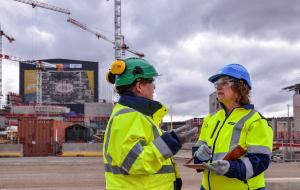The MOMENTUM Joint Venture joined ITER's quest for fusion energy in the summer of 2016 as Construction Manager-as-Agent (CMA). Its main task, according to Project Director Angie Jones, is to bring all the strands together and make sure that the ITER machine and plant are assembled and installed on time, safely and in compliance with budget.
"Our mission is to manage, coordinate, and supervise assembly and installation activities on behalf of the ITER Organization. As CMA, we share industry best practice for large construction projects, and adapt it for implementation at ITER."
MOMENTUM is led by Wood (UK, formerly Amec Foster Wheeler) in partnership with Assystem (France) and KEPCO Engineering and Construction (Korea).
Based on already completed scientific and engineering work, MOMENTUM puts together controllable construction work packages for the contractors, who in turn break them down into installation work packages. "These detailed packages allow us to monitor and measure the work as the construction manager," says Jones.
Jones and her 70 colleagues are fully focused on their mission as ITER's construction management partner. They deliver processes and procedures for all phases: construction preparation, project management, contract management, interface management, site coordination, construction supervision and completion.
The biggest part of her job is integration—bringing all the elements together and identifying gaps. This means raising the focus from specific engineering and manufacturing tasks to the long-term goal--achieving First Plasma in 2025.
It all comes down to perspective, according to Jones. "Chickens keep pecking on the ground, never looking up to see what's going on elsewhere. But the eagle can see everything from a great height," says Jones. "We must shift to a project delivery culture in which construction needs drive the engineering and procurement priorities.


